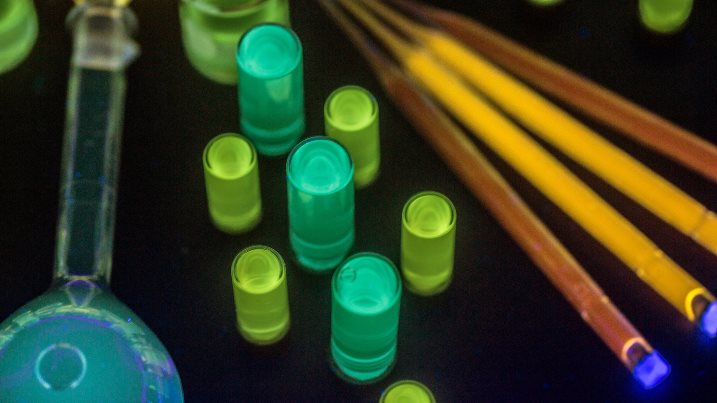How Stenotrophomonas maltophila led to a biotech discovery
Quantum dots are tiny crystals that may offer sharper and brighter images for cellphones and TVs, for less money. Bryan Berger, a co-author of a study published in Proceedings of the National Academy of Sciences last week, stumbled across an alternative for creating the little dots through an unintended sequence of events. It began when an alarmed hospital staff in Pennsylvania discovered a superbug growing on metal surfaces in 2011.
 Berger’s team of chemical engineers at Lehigh University discovered, through this, an environmentally friendly way to create the dots: Feed some metal to a single enzyme extracted from bacteria. The colorful vials, pictured right, are filled with the little dots grown in a lab at Lehigh through this cost-effective method. Under LED lights, the little crystals, which can generate both electricity and colored light, glow like plastic pegs on a Lite-Brite screen.
Berger’s team of chemical engineers at Lehigh University discovered, through this, an environmentally friendly way to create the dots: Feed some metal to a single enzyme extracted from bacteria. The colorful vials, pictured right, are filled with the little dots grown in a lab at Lehigh through this cost-effective method. Under LED lights, the little crystals, which can generate both electricity and colored light, glow like plastic pegs on a Lite-Brite screen.
Doctors and nurses were worried: Stenotrophomonas maltophila, or steno, as the bacteria is called, can potentially cause bad infections in immune-compromised patients, and few antibiotics can kill it. So they asked Dr. Berger, a chemical engineer at nearby Lehigh, to find out why the bacteria seemed to thrive on metal.
What Dr. Berger found surprised him. The microbe appeared to be taking in electrical charges, presumably from the metal surfaces, and spitting out clusters of tiny, metallic particles. Dr. Berger did not know how to halt the superbug, but what he saw sparked his imagination. Could this same bacteria that was spitting out metal be re-engineered as a mini-crystal-generating machine?
He and his colleagues found that within a few minutes of feeding the metal cadmium to the steno bacteria — bam — they had created quantum dots.
They published those findings last year. The problem was that they were using a potentially infectious bug to create the dots. What’s significant about the new study is that Dr. Berger and his colleagues Steve McIntosh and Chris Kiely discovered that they didn’t need the bacteria after all; they could make the dots with a single enzyme inside it.
The dots could be helpful in other ways than improving screen technology: quantum dots are already being developed in medical imaging to tag tumors and identify diseases, and are being closely watched by manufacturers of green energy, for their potential to boost the efficiency of solar cells. These new dots, if they can be engineered to be even brighter, may have applications there. But that’s a big if.
Read the full article on The New York Times website.
Photo credits: Christa Neu/Lehigh University
